We hear a lot about the benefits of “innovation” and “innovators.” It’s no small wonder: most of the stories we tell about social and technological “progress” are about a few dedicated people coming up with a new approach and changing the world. Historians, being the prickly and un-fun group that we are, tend to cast a jaundiced eye at these kinds of stories. Often these kinds of cases ignore the broader contextual circumstances that were required for the “innovation” to appear or take root, and often the way these are told tend to make the “innovator” seem more “out of their time” than they really were.

The “logo” of the Maintainers conference, which graces its T-shirts (!) and promotional material. I modeled the manhole design off of an actual manhole cover here in Hoboken (photograph taken by me).
Two of my colleagues (Andy Russell and Lee Vinsel) at the Science and Technology Studies program here at the Stevens Institute of Technology (official tagline: “The Innovation University“) have been working on an antidote to these “innovation studies.” This week they are hosting a conference called “The Maintainers,” which focuses on an alternative view of the history of technology. The core idea (you can read more on the website) is that the bulk of the life and importance of a technology is not in its moment of “innovation,” but in the “long tail” of its existence: the ways in which it gets integrated into society, needs to be constantly repaired and upgraded, and can break down catastrophically if it loses its war against entropy. There is a lot of obvious resonance with infrastructure studies and stories in the news lately about what happens if you don’t repair your water systems, bridges, subway trains, and you-name-it. 1
I’ve been thinking about how this approach applies to the history and politics of nuclear weapons. It’s pretty clear from even a mild familiarity with the history of the bomb that most of the stories about it are “innovation” narratives. The Manhattan Project is often taken as one of the canonical cases of scientific and technological innovation (in ways that I find extremely misleading and annoying). We hunger for those stories of innovation, the stories of scientists, industry, and the military coming together to make something unusual and exciting. When we don’t think the weapons-acquisition is a good idea (e.g., in the Soviet Union, North Korea, what have you), these innovation stories take on a more sinister tone or get diluted by allusions to espionage or other “help.” But the template is the same. Richard Rhodes’ The Making of the Atomic Bomb is of course one of the greatest works of the innovation narrative of the atomic bomb, starting, as it does, with a virtual lightning bolt going off in the mind of Leo Szilard. 2
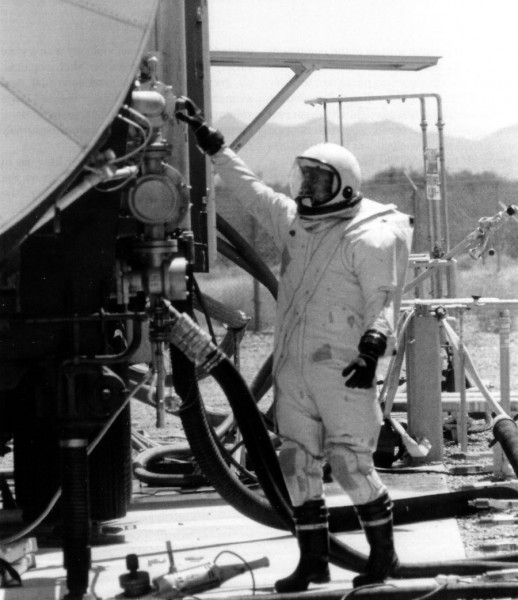
How do you service a Titan II missile? Very carefully. This is a RFHCO suit, required for being around the toxic fuel and oxidizer. Not the most comfortable of outfits. From Penson’s Titan II Handbook.
What would a history of the bomb look like if we focused on the question of “maintenance”? We don’t have to guess, actually: one already exists. Eric Schlosser’s Command and Control, which I reviewed on here and for Physics Today a few years ago, can be read in that light. Schlosser’s book is about the long-term work it takes to create a nuclear-weapons infrastructure, both in terms of producing the weapons and in terms of making sure they are ready to be used when you want them to be. And, of course, it’s about what can go wrong, either in the course of routine maintenance (the central case-study is that of a Titan II accident that starts when a “maintainer” accidentally drops a socket wrench) or just in the haphazard course of a technology’s life and interactions with the physical world (dropped bombs, crashed planes, things that catch on fire, etc.). (A documentary film based on Schlosser’s book premieres at the Tribeca Film festival this month, along with what sounds like a nuclear rave.)
There are other approaches we might fold into the “maintenance” of the bomb. Donald MacKenzie’s Inventing Accuracy uses the trope of invention, but the meat of the book is really about the way uncertainty about performance and reliability moved between the domains of engineering and policy. Hugh Gusterson’s anthropological study of the Livermore laboratory, Nuclear Rites, is particularly astute about the questions of the day-to-day work at a weapons laboratory and who does it. And the maintenance of infrastructure is a major sub-theme of Stephen Schwartz‘s classic edited volume on the costs of the nuclear complex, Atomic Audit. But these kinds of studies are, I think, rarer than they ought to be — we (and I include myself in this) tend to focus on the big names and big moments, as opposed to the slow-grind of the normal.
There are two historical episodes that come to my mind when I think about the role of “maintenance” in the history of nuclear weapons. Non-coincidentally, both come at points in history where big changes were in the making: the first right after World War II ended, the second right after the Cold War ended.
Episode 1: The postwar slump
From the very beginning, the focus on the bomb was about its moment of creation. Not, in other words, on what it would take to sustain a nuclear complex. In our collective memory, a “Manhattan Project” is a story of intense innovation and creative invention against all odds. But there’s a lesser-known historical lesson in what happened right after the bombs went off, and it’s worth keeping in mind anytime someone invokes the need for another “Manhattan Project.”
The Manhattan Project, formally begun in late 1942, was consciously an effort to produce a usable atomic bomb in the shortest amount of time possible. It involved massive expenditure, redundant investigations, and involved difficult trade-offs between what would normally considered “research” and “development” phases. Plans for the first industrial-sized nuclear reactors, for example, were developed almost immediately after the first proof-of-concept was shown to work — normal stages of prototyping, scaling, and experimenting were highly compressed from normal industrial practices at the time, a fact noted by the engineers and planners who worked on the project. The rush towards realization of the new technology drove all other concerns. The nuclear waste generated by the plutonium production processes, for example, were stored in hastily-built, single-walled underground tanks that were not expected to be any more than short-term, wartime solutions. 3 When people today refer to the Manhattan Project as a prototypical case of “throw a lot of money and expertise at a short-term problem,” they aren’t entirely wrong (even though such an association leaves much out).
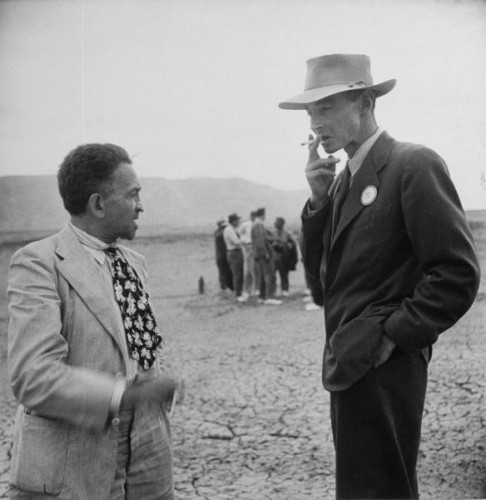
J. Robert Oppenheimer (at right) was proud face of the successful “innovation” of the Manhattan Project. It is telling, though, that he left Los Alamos soon after the war ended. Source: Google LIFE image archive.
After the end of World War II, though, the future of the American nuclear complex was uncertain. In my mind this liminal period is as interesting as the wartime period, though it doesn’t get as much cultural screen time. Would the US continue to make nuclear weapons? Would there be an agreement in place to limit worldwide production of nuclear arms (international control)? Would the atomic bomb significantly change US expenditures on military matters, or would it become simply another weapon in the arsenal? What kind of postwar organization would manage the wartime-creations of the Manhattan Project? No one knew the answers to these questions — there was a swirl of contradictory hopes and fears held by lots of different stakeholders.
We know, in the end, what eventually worked out. The US created the civilian Atomic Energy Commission with the Atomic Energy Act of 1946, signed by President Truman in August 1946 (much later than the military had hoped). Efforts towards the “international control” of the atomic bomb fizzled out in the United Nations. The Cold War began, the arms race intensified, and so on.
But what’s interesting to me, here, is that period between the end of the war and things “working out.” Between August 1945 and August 1946, the US nuclear weapons infrastructure went into precipitous decline. Why? Because maintaining it was harder than building it in the first place. What needed to be maintained? First and foremost, there were issues in maintaining the human capital. The Manhattan Project was a wartime organization that dislocated hundreds of thousands of people. The working conditions were pretty rough and tumble — even during the war they had problems with people quitting as a result of them. When the war ended, a lot of people went home. How many? Exact numbers are hard to come by, but my rough estimate based on the personnel statistics in the Manhattan District History is that between August 1945 and October 1946, some 80% of the construction labor left the project, and some 30% of the operations and research labor left. Overall there was a shedding of some 60% of the entire Manhattan Project labor force.

Declines in Manhattan Project personnel from July 1945 through December 1946. Note the dramatic decrease between August and September 1945, and the slow decrease until October 1946, after the Atomic Energy Act was passed and when things started to get on a postwar footing (but before the Atomic Energy Commission fully took over in January 1947). Reconstructed from this graph in the Manhattan District History.
Now, some of that can be explained as the difference between a “building” project and a “producing” project. Construction labor was already on a downward slope, but the trend did accelerate after August 1945. The dip in operations and research, though, is more troublesome — a steep decline in the number of people actually running the atomic bomb infrastructure, much less working to improve it.
Why did these people leave? In part, because the requirements of a “crash” program and a “long-term” program were very different in terms of labor. It’s more than just the geographical aspect of people going home. It also included things like pay, benefits, and work conditions in general. During the war, organized labor had mostly left the Manhattan Project alone, at the request of President Roosevelt and the Secretary of War. Once peace was declared, they got back into the game, and were not afraid to strike. Separately, there was a prestige issue. You can get Nobel Prize-quality scientists to work on your weapons program when you tell them that Hitler was threatening civilization, that they were going to open up a new chapter in world history, etc. It’s exciting to be part of something new, in any case. But if the job seems like it is just about maintaining an existing complex — one that many of the scientists were having second-thoughts on anyway — it’s not as glamorous. Back to the universities, back to the “real” work. 4
And, of course, it’s a serious morale problem if you don’t think you laboratory is going to exist in a year or two. When the Atomic Energy Act got held up in Congress for over a year, it introduced serious uncertainty as to the future of Los Alamos. Was Los Alamos solely a wartime production or a long-term institution? It wasn’t clear.
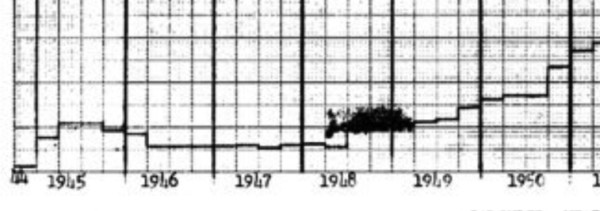
Hanford reactor energy output, detail. Note that it went down after late 1945, and they did not recover their wartime capacity until late 1948. Source: detail from this chart which I got from the Hanford Declassified Document System.
There were also technical dimensions to the postwar slump. The industrial-sized nuclear reactors at Hanford had been built, as noted, without much prototyping. The result is that there was still much to know about how to run them. B Reactor, the first to go online, started to show problems in the immediate postwar. Some of the neutrons being generated from the chain reaction were being absorbed by the graphite lattice that served as the moderator. The graphite, as a result, was starting to undergo small chemical changed: it was swelling. This was a big problem. Swelling graphite could mean that the channels that stored fuel or let the control rods in could get warped. If that happened, the operator would no longer be in full control of the reactor. That’s bad. For the next few years, B Reactor was run on low power as a result, and the other reactors were prevented from achieving their full output until solutions to the problem were found. The result is that the Hanford reactors had around half the total energy output in the immediate postwar as they did during the wartime period — so they weren’t generating as much plutonium.
To what degree were the technical and the social problems intertwined? In the case of Los Alamos we have a lot of documentation from the period which describes the “crisis” of the immediate postwar, when they were hemorrhaging manpower and expertise. We also have some interesting documentation that implies the military was worried about what a postwar management situation might look like, if it was out of the picture — if the nuclear complex was to be run by civilians (as the Atomic Energy Act specified), they wanted to make sure that the key aspects of the military production of nuclear weapons were in “reliable” hands. In any case, the infrastructure, as it was, was in a state of severe decay for about a year as these things got worked out.
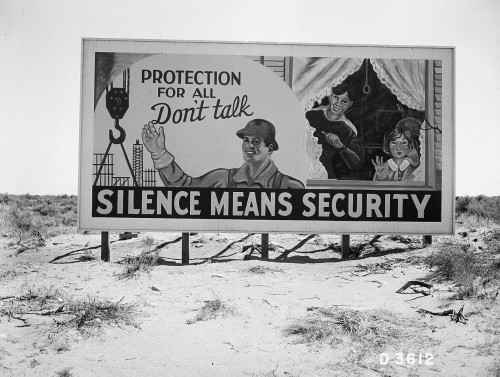
I haven’t even touched on the issues of “maintaining” security culture — what goes under the term “OPSEC.” There is so much that could be said about that, too! Image source: (Hanford DDRS #N1D0023596)
The result of all of this was the greatest secret of the early postwar: the United States had only a small amount of fissile material, a few parts of other bomb components, and no ready-to-use nuclear weapons. AEC head David Lilienthal recalled talking with President Truman in April 1947:
We walked into the President’s office at a few moments after 5:00 p.m. I told him we came to report what we had found after three months, and that the quickest way would be to ask him to read a brief document. When he came to a space I had left blank, I gave him the number; it was quite a shock. We turned the pages as he did, all of us sitting there solemnly going through this very important and momentous statement. We knew just how important it was to get these facts to him; we were not sure how he would take it. He turned to me, a grim, gray look on his face, the lines from his nose to his mouth visibly deepened. What do we propose to do about it? 5
The “number” in question was the quantity of atomic bombs ready to use in an emergency. And it was essentially zero. 6 Thus the early work of the AEC was re-building a postwar nuclear infrastructure. It was expensive and slow-going, but by 1950 the US could once again produce atomic bombs in quantity, and was in a position to suddenly start producing many types of nuclear weapons again. Thus the tedious work of “maintenance” was actually necessary for the future work of “innovation” that they wanted to happen.
Episode 2: The post-Cold War question
Fast-forward to the early 1990s, and we’re once again in at a key juncture in questions about the weapons complex. The Soviet Union is no more. The Cold War is over. What is the future of the American nuclear program? Does the United States still need two nuclear weapon design laboratories? Does it still need a diverse mix of warheads and launchers? Does it still need the “nuclear triad”? All of these questions were on the table.
What shook out was an interesting situation. The labs would be maintained, shifting their efforts away from the activities we might normally associate with innovation and invention, and towards activities we might instead associate with maintenance. So environmental remediation was a major thrust, as was the work towards “Science-Based Stockpile Stewardship,” which is a fancy term for maintaining the nuclear stockpile in a state of readiness. The plants that used to assemble nuclear weapons have converted into places where weapons are disassembled, and I’ve found it interesting that the imagery associated with these has been quite different than the typical “innovation” imagery — the people shown in the pictures are “technicians” more than “scientists,” and the prevalence of women seems (in my anecdotal estimation) much higher.
The question of what to do with the remaining stockpile is the most interesting. I pose the question like this to my undergraduate engineers: imagine you were given a 1960s Volkswagen Beetle and were told that once you were pretty sure it would run, but you never ran that particular car before. Now imagine you have to keep that Beetle in a garage for, say, 20 or 30 more years. You can remove any part from the car and replace it, if you want. You can run tests of any sort on any single component, but you can’t start the engine. You can build a computer model of the car, based on past experience with similar cars, too. How much confidence would you have in your ability to guarantee, with near 100% accuracy, that the car would be able to start at any particular time?
Their usual answer: not a whole lot. And that’s without telling them that the engine in this case is radioactive, too.

Graph of Livermore nuclear weapons designers with and without nuclear testing experience. The PR spin put on this is kind of interesting in and of itself: “Livermore physicists with nuclear test experience are reaching the end of their careers, and the first generation of stockpile stewards is in its professional prime.” Source: Arnie Heller, “Extending the Life of an Aging Weapon,” Science & Technology Review (March 2012).
Like all analogies there are inexact aspects to it, but it sums up some of the issues with these warheads. Nuclear testing by the United States ceased in 1992. It might come back today (who knows?) but the weapons scientists don’t seem to be expecting that. The warheads themselves were not built to last indefinitely — during the Cold War they would be phased out every few decades. They contain all sorts of complex materials and substances, some of which are toxic and/or radioactive, some of which are explosive, some of which are fairly “exotic” as far as materials go. Plutonium, for example, is metallurgically one of the most complex elements on the periodic table and it self-irradiates, slowly changing its own chemical structure.
Along with these perhaps inherent technical issues is the social one, the loss of knowledge. The number of scientists and engineers at the labs that have had nuclear testing experience is at this point approaching zero, if it isn’t already there. There is evidence that some of the documentary procedures were less than adequate: take the case of the mysterious FOGBANK, some kind of exotic “interstage” material that is used in some warheads, which required a multi-million dollar effort to come up with a substitute when it was discovered that the United States no longer had the capability of producing it.
So all of this seems to have a pretty straightforward message, right? That maintenance of the bomb is hard work and continues to be so. But here’s the twist: not everybody agrees that the post-Cold War work is actually “maintenance.” That is, how much of the stockpile stewardship work is really just maintaining existing capability, and how much is expanding it?
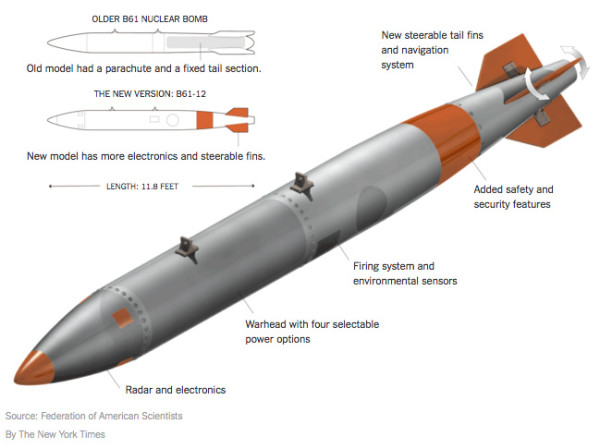
Old warheads in new bottles? Summary of the new features of the B-61 Mod 12, via the New York Times.
The B-61 Mod 12 has been in the news a bit lately for this reason. The B-61 is a very flexible warhead system that allows for a wide range of yield settings for a gravity bomb. The Mod 12 has involved, among other things, an upgraded targeting and fuzing capability for this bomb. This makes the weapon very accurate and allows it to penetrate some degree into the ground before detonating. The official position is that this upgrade is necessary for the maintenance of the US deterrence position (it allows it, for example, to credibly threaten underground bunkers with low-yield weapons that would reduce collateral damage). So now we’re in a funny position: we’re upgrading (innovating?) part of a weapon in the name of maintaining a policy (deterrence) and ideally with minimal modifications to the warhead itself (because officially we are not making “new nuclear weapons”). Some estimates put the total cost of this program at a trillion dollars — which would be a considerable fraction of the total money spent on the entire Cold War nuclear weapons complex.
There are other places where this “maintenance” narrative has been challenged as well. The labs in the post-Cold War argued that they could only guarantee the stockpile’s reliability if they got some new facilities. Los Alamos got DARHT, which lets them take 3-D pictures of implosion in realtime, Livermore got NIF, which lets them play with fusion micro-implosions using a giant laser. A lot of money has been put forward for this kind of “maintenance” activity, and as you can imagine there was a lot of resistance. With all of it has come the allegations that, again, this is not really necessary for “maintenance,” that this is just innovation under the guise of maintenance. And if that’s the case, then that might be a policy problem, because we are not supposed to be “innovating” nuclear weapons anymore — that’s the sort of thing associated with arms races. For this reason, one major effort to create a warhead design that was alleged to be easier to maintain, the Reliable Replacement Warhead, was killed by the Obama administration in 2009.
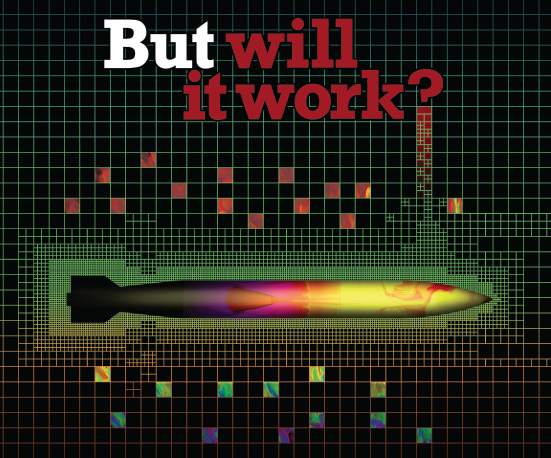
“But will it work?” With enough money thrown at the problem, the answer is yes, according to Los Alamos. Source: National Security Science (April 2013).
So there has been a lot of money in the politics of “maintenance” here. What I find interesting about the post-Cold War moment is that “maintenance,” rather than being the shabby category that we usually ignore, has been moved to the forefront in the case of nuclear weapons. It is relatively easy to argue, “yes, we need to maintain these weapons, because if we don’t, there will be terrible consequences.” Billions of dollars are being allocated, even while other infrastructures in the United States are allowed to crumble and decline. The labs in particular have to walk a funny line here. They have an interest in emphasizing the need for further maintenance — it’s part of their reason for existence at this point. But they also need to project confidence, because the second they start saying that our nukes don’t work, they are going to run into even bigger policy problems.
And yet, it has been strongly alleged that under this cloak of maintenance, a lot of other kinds of activities might be taking place as well. So here is a perhaps an unusual politics of maintenance — one of the few places I’ve seen where there is a substantial community arguing against it, or at least against using it as an excuse to “innovate” on the sly.
- Andy and Lee just published a great article outlining their argument on Aeon Magazine: “Hail the maintainers.”[↩]
- “In London, where Southampton Row passes Russell Square, across from the British Museum in Bloomsbury, Leo Szilard waited irritably one gray Depression morning for the stoplight to change. A trace of rain had fallen during the night; Tuesday, September 12, 1933, dawned cool, humid and dull. … The stoplight changed to green. Szilard stepped off the curb. As he crossed the street time cracked open before him and he saw a way to the future, death into the world and all our woe, the shape of things to come.” Richard Rhodes, The Making of the Atomic Bomb (New York: Simon and Schuster, 1986), 13. For a critical view of Rhodes, looking at how Rhodes’ mobilizes the trope of invention in his narrative, see esp. Hugh Gusterson, “Death of the authors of death: Prestige and creativity among nuclear weapons scientists,” in Mario Biagioli and Peter Galison, eds., Scientific authorship: Credit and intellectual property in science (New York: Routledge, 2003), 281-307.[↩]
- J. Samuel Walker, The Road to Yucca Mountain: The Development of Radioactive Waste Policy in the United States (Los Angeles/Berkeley: University of California Press, 2009), 2-6.[↩]
- Hence Edward Teller’s attempt to convince the scientists go to “back to the labs” to solve the H-bomb problem a few years later.[↩]
- David E. Lilienthal, The Journals of David E. Lilienthal, Volume II: The Atomic Energy Years, 1945-1950 (New York: Harper and Row, 1964), p. 165. Side-note: As Lilienthal was leaving Truman’s office, Truman told him that, “You have the most important thing there is. You must making a blessing of it or,” — and then Truman pointed to a large globe in the corner of the office — “we’ll blow all that to smithereens.”[↩]
- They had bomb cores, they had non-nuclear bomb assemblies, but there is little to suggest that they had anything ready to go on a short term — it would take weeks to assemble the weapons and get them into a state of readiness. The total cores on hand at Los Alamos at the end of 1945 was 2; for 1946 it was 9; for 1947 it was 13. Senator Brien McMahon later said that “when the [AEC] took over [in 1947] there were exactly two bombs in the locker,” Lilienthal himself later said that “we had one [bomb] that was probably operable when I first went off to Los Alamos [January 1947]; one that had a good chance of being operable.” Quoted in Gregg Herken, Brotherhood of the Bomb (New York: Henry Holt, 2002), 137 fn. 84. Lilienthal told Herken: “The politically significant thing is that there really were no bombs in a military sense… We were really almost without bombs, and not only that, we were without people, that was the really significant thing… You can hardly exaggerate the unreadiness of the U.S. military men at this time.” Quoted in Gregg Herken, The Winning Weapon: The Atomic Bomb in the Cold War (Princeton: Princeton University Press, 1988 [1981]), 196-197 (in the unnumbered footnote).[↩]


Hi Alex,
long time lurker, first time posting etc…
First off, thanks for your insights into an interesting part of our history. FWIW, an relative of mine served in the military support units for the Australian Army at the Maralinga nuclear tests in South Australia, in ’56 or ’57
You mention T-shirts with the “maintainers logo” on them; Obviously, I can just print the logo at the top of the article on to a t shirt of my own, but I’d rather send some cash your way (or the way of the conference).
Are these T-shirts actually available, or is it just some hyperbole on your behalf ?
(BTW, I’ve also mailed the contact address on the maintainers.org website)
thanks